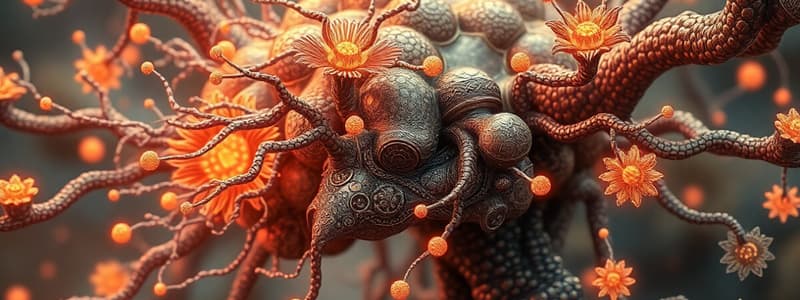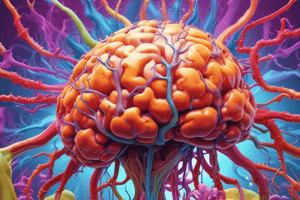Podcast
Questions and Answers
Which class of drugs targets axonal voltage-gated ion channels?
Which class of drugs targets axonal voltage-gated ion channels?
- Antihistamines
- Antidepressants
- β-blockers
- Calcium channel blockers (correct)
What is the main effect of phenytoin on voltage-gated sodium channels?
What is the main effect of phenytoin on voltage-gated sodium channels?
- It increases the firing rate of action potentials.
- It activates calcium influx through the channels.
- It stabilizes the Nav channels that are inactivated. (correct)
- It enhances synaptic release of glutamate.
Which voltage-gated sodium channel is NOT expressed in the nervous system?
Which voltage-gated sodium channel is NOT expressed in the nervous system?
- Nav1.5
- Nav1.6
- Nav1.4 (correct)
- Nav1.1
Which option correctly describes the mechanism of action of carbamazepine?
Which option correctly describes the mechanism of action of carbamazepine?
What does TTX-sensitive mean in the context of voltage-gated sodium channels?
What does TTX-sensitive mean in the context of voltage-gated sodium channels?
What is the primary medical indication for phenytoin?
What is the primary medical indication for phenytoin?
What type of voltage-gated ion channel primarily determines the threshold for firing an action potential?
What type of voltage-gated ion channel primarily determines the threshold for firing an action potential?
Which of the following drugs does NOT target monoaminergic neurotransmitters?
Which of the following drugs does NOT target monoaminergic neurotransmitters?
What component of the voltage-gated sodium channel acts as a voltage sensor?
What component of the voltage-gated sodium channel acts as a voltage sensor?
What is the role of the β-subunit in voltage-gated sodium channels?
What is the role of the β-subunit in voltage-gated sodium channels?
What is the primary medical indication of Ethosuximide?
What is the primary medical indication of Ethosuximide?
Which type of calcium channel is mainly found in the brain and peripheral nervous system?
Which type of calcium channel is mainly found in the brain and peripheral nervous system?
What effect does Retigabine have on voltage-gated potassium channels?
What effect does Retigabine have on voltage-gated potassium channels?
How does Buspirone act on 5-HT1A receptors?
How does Buspirone act on 5-HT1A receptors?
What is the role of the α2δ subunit in voltage-gated calcium channels?
What is the role of the α2δ subunit in voltage-gated calcium channels?
What is a medical indication for the use of CGRP/substance P modulators?
What is a medical indication for the use of CGRP/substance P modulators?
Which of the following best describes the physiological effect of voltage-gated potassium channels?
Which of the following best describes the physiological effect of voltage-gated potassium channels?
What is the primary action of Ondansetron and Granisetron?
What is the primary action of Ondansetron and Granisetron?
What neurological function is primarily associated with the 5-HT pathways projecting to the limbic forebrain?
What neurological function is primarily associated with the 5-HT pathways projecting to the limbic forebrain?
What does Gabapentin primarily target in treatment?
What does Gabapentin primarily target in treatment?
Which condition is Haloperidol NOT used to treat?
Which condition is Haloperidol NOT used to treat?
Which receptors do Metoclopramide antagonize?
Which receptors do Metoclopramide antagonize?
Which type of calcium channel is known for its transient characteristics and is involved with pacemaker activity in certain cells?
Which type of calcium channel is known for its transient characteristics and is involved with pacemaker activity in certain cells?
Which statement correctly describes the role of voltage-gated sodium channels?
Which statement correctly describes the role of voltage-gated sodium channels?
What is a common indication for the use of 5-HT3 receptor modulators?
What is a common indication for the use of 5-HT3 receptor modulators?
What effect do antagonists of dopamine D2 receptors have on the chemoreceptor trigger zone?
What effect do antagonists of dopamine D2 receptors have on the chemoreceptor trigger zone?
Which statement is true about the action of Metoclopramide?
Which statement is true about the action of Metoclopramide?
Which neurotransmitter's receptors are targeted by Haloperidol for its antipsychotic effect?
Which neurotransmitter's receptors are targeted by Haloperidol for its antipsychotic effect?
Which of the following is NOT a characteristic of 5-HT3 receptors?
Which of the following is NOT a characteristic of 5-HT3 receptors?
What is the role of CGRP and substance P in the context of migraine management?
What is the role of CGRP and substance P in the context of migraine management?
What is the main medical indication for using agonists of the 5-HT4 receptor?
What is the main medical indication for using agonists of the 5-HT4 receptor?
Which receptors do risperidone primarily antagonize to alleviate symptoms in schizophrenia?
Which receptors do risperidone primarily antagonize to alleviate symptoms in schizophrenia?
What is the role of 5-HT1A receptors in the action of SSRIs?
What is the role of 5-HT1A receptors in the action of SSRIs?
Which of the following best describes the mechanism of action for selective serotonin reuptake inhibitors (SSRIs)?
Which of the following best describes the mechanism of action for selective serotonin reuptake inhibitors (SSRIs)?
What is a common treatment duration necessary before SSRIs manifest clinical effects?
What is a common treatment duration necessary before SSRIs manifest clinical effects?
Which condition is NOT among the medical indications for SSRIs?
Which condition is NOT among the medical indications for SSRIs?
What is one significant outcome of blocking 5-HT2A receptors with risperidone?
What is one significant outcome of blocking 5-HT2A receptors with risperidone?
What is the primary effect of selective serotonin reuptake inhibitors on serotonin transporters?
What is the primary effect of selective serotonin reuptake inhibitors on serotonin transporters?
What effect does decreased 5-HT1A receptor activity have on serotonin neurotransmission?
What effect does decreased 5-HT1A receptor activity have on serotonin neurotransmission?
Which of the following drug classes does risperidone belong to?
Which of the following drug classes does risperidone belong to?
Flashcards
Voltage-gated sodium channels (Nav)
Voltage-gated sodium channels (Nav)
Ion channels in axons that open and close in response to changes in membrane potential, crucial for action potential generation.
Action potential
Action potential
Rapid, temporary changes in membrane potential that propagate along the axon, allowing communication between neurons.
Phenytoin
Phenytoin
A drug that blocks voltage-gated sodium channels, used to treat epilepsy.
Sodium channel blocker
Sodium channel blocker
Signup and view all the flashcards
Epilepsy
Epilepsy
Signup and view all the flashcards
Refractory period
Refractory period
Signup and view all the flashcards
Voltage-gated potassium channels (Kv)
Voltage-gated potassium channels (Kv)
Signup and view all the flashcards
Neurotransmitter release
Neurotransmitter release
Signup and view all the flashcards
Axonal Terminal
Axonal Terminal
Signup and view all the flashcards
Carbamazepine
Carbamazepine
Signup and view all the flashcards
Voltage-gated calcium channels (Cav)
Voltage-gated calcium channels (Cav)
Signup and view all the flashcards
Cav subtypes
Cav subtypes
Signup and view all the flashcards
Ethosuximide's function
Ethosuximide's function
Signup and view all the flashcards
Gabapentin's mechanism
Gabapentin's mechanism
Signup and view all the flashcards
Voltage-gated potassium channels
Voltage-gated potassium channels
Signup and view all the flashcards
Retigabine's action
Retigabine's action
Signup and view all the flashcards
Serotonergic neurons
Serotonergic neurons
Signup and view all the flashcards
5-HT1A receptors
5-HT1A receptors
Signup and view all the flashcards
Buspirone mechanism
Buspirone mechanism
Signup and view all the flashcards
Sumatriptan's target
Sumatriptan's target
Signup and view all the flashcards
5-HT4 Receptor Agonist
5-HT4 Receptor Agonist
Signup and view all the flashcards
Antiemetic Drug
Antiemetic Drug
Signup and view all the flashcards
Dopamine D2 & 5-HT Receptor Modulators
Dopamine D2 & 5-HT Receptor Modulators
Signup and view all the flashcards
Risperidone
Risperidone
Signup and view all the flashcards
Serotonin Reuptake Inhibitor (SSRI)
Serotonin Reuptake Inhibitor (SSRI)
Signup and view all the flashcards
SSRIs and 5-HT1A Receptors
SSRIs and 5-HT1A Receptors
Signup and view all the flashcards
Sertraline & Fluoxetine
Sertraline & Fluoxetine
Signup and view all the flashcards
Bulimia Nervosa
Bulimia Nervosa
Signup and view all the flashcards
Obsessive-Compulsive Disorder (OCD)
Obsessive-Compulsive Disorder (OCD)
Signup and view all the flashcards
Why Do SSRIs Take Time to Work?
Why Do SSRIs Take Time to Work?
Signup and view all the flashcards
CGRP/Substance P
CGRP/Substance P
Signup and view all the flashcards
5-HT3 Receptor Antagonists
5-HT3 Receptor Antagonists
Signup and view all the flashcards
Dopamine D2 Receptor Antagonist
Dopamine D2 Receptor Antagonist
Signup and view all the flashcards
Metoclopramide's Action
Metoclopramide's Action
Signup and view all the flashcards
Migraine Treatment
Migraine Treatment
Signup and view all the flashcards
Antiemetic Drugs - Mechanism
Antiemetic Drugs - Mechanism
Signup and view all the flashcards
Haloperidol: Use Cases
Haloperidol: Use Cases
Signup and view all the flashcards
Chemoreceptor Trigger Zone
Chemoreceptor Trigger Zone
Signup and view all the flashcards
Striatum
Striatum
Signup and view all the flashcards
Dopamine D2 Blockade - Effect
Dopamine D2 Blockade - Effect
Signup and view all the flashcards
Study Notes
Applied Pharmacology of the Nervous and Endocrine System - Modulators of Neuronal Excitability
- The course covers modulators of neuronal excitability, including drugs targeting axonal voltage-gated ion channels and monoaminergic neurotransmitters.
- Learning objectives include identifying drug classes targeting these elements and their mechanisms of action in affecting neuronal activity.
- Clinical indications for these drugs are also a focus.
Drugs that will be covered in this lecture
- Drugs targeting axonal voltage-gated ion channels are a subject of the lecture
- Drugs targeting monoaminergic neurotransmitters are also included in the lecture.
- The lecture will contain diagrammatic representations of neuronal structures and their components.
Types of voltage-gated ion channels
- Voltage-gated sodium (NaV) channels
- Voltage-gated potassium (Kv) channels
- Voltage-gated Calcium (CaV) channels
- Abundant in axon initial segment (AIS)
- Determine threshold for action potential firing
- Calcium influx pivotal for neurotransmitter release
Voltage-gated sodium channels (detailed)
- 10 different Nav subtypes in mammals
- Classified based on α-subunit differences
- Some are CNS-specific (Nav1.1-Nav1.3, Nav1.5, Nav1.6)
- Others are PNS-specific (Nav1.7-Nav1.9)
- α-subunit (260 kDa) forms the pore
- 4 homologous transmembrane domains (I-IV)
- Each domain includes 6 transmembrane segments (S1-S6)
- S4 is the voltage sensor, related to activation
- TTX sensitive or resistant based on subtype
- Multiple intracellular loops
- Auxiliary β-subunits (33-36 kDa)
- Four subtypes (β1-β4) regulate α-subunit function.
Modulators of voltage-gated sodium channels
- Phenytoin: non-specific sodium channel blocker, stabilizes inactivated ion channels, prolongs neuronal refractory period.
- Medical indication: epilepsy/seizures.
- Carbamazepine: non-specific sodium channel blocker that affects other ion channels, stabilizes inactivated ion channels, prolongs neuronal refractory period.
- Medical indication: epilepsy, trigeminal neuralgia, mania.
Voltage-gated calcium channels (detailed)
- Ca²⁺: a second messenger for many cellular regulations
- Voltage-gated calcium channels (Cav) are activated by membrane depolarization and mediate calcium influx for action potentials and sub-threshold depolarisations.
- Five subunits
- a1: pore-forming; has 4 homologous I-IV domains and 6 transmembrane segments
- a20: disulfide-linked glycoprotein dimer, drug target for gabapentinoids
- β: intracellular subunit, stabilizes a1 conformation
- γ: transmembrane glycoprotein subunit
- Five types of CaV channels: L, N, P, R, and T.
Modulators of voltage-gated calcium channels
- Ethosuximide: Blocks T-type calcium channels; Effective for treating absence seizures
- Gabapentin: Modulates a₂δ subunit, lowers synaptic transmission and neuronal excitability, reducing neurotransmitter release.
- Medical indications: epilepsy, neuropathic pain, multiple sclerosis.
Voltage-gated potassium channels
- Form from six transmembrane helices (S1-S6)
- S1-S4 are the voltage sensors, and S5-S6 is the pore
- K⁺ ions leave the cells upon depolarisation
- Decrease the probability of action potentials
- Reduces neuronal activity.
Modulators of voltage-gated potassium channels
- Retigabine: binds to Kv7 potassium channels, increases conductance of K⁺ ions, increases hyperpolarisation, reduces action potential frequency to decrease neuronal excitability, effective in treatment of epilepsy.
5-Hydroxytryptamine (5-HT) pathways
- Behavior effects, mood, perception, memory, aggression.
- CNS effects, motor control, sleep, CNS vascular tone, temperature regulation.
- Central serotonergic drugs: SSRIs, tricyclic antidepressants, MAOIs, atypical antipsychotics, triptans.
Serotonin receptors
- GPCR coupled to, Gi/o, Gq, or Gs (types 1, 2, 4, 5, 6, and 7)
- Ligand-gated ion channel (type 3)
Modulators of 5-HT receptors
- Buspirone: partial agonist of 5-HT1A receptors, decreases further 5-HT release (auto-receptors are activated)
- Medical indication: short-term use for anxiety.
- Sumatriptan: agonist of 5-HT1B/D receptors affecting trigeminal nerve endings and decreasing CGRP/substance P.
- Medical indication: acute migraine, cluster headaches.
- Ondansetron & Granisetron: antagonists of 5-HT3 receptors; block vagal afferents and chemoreceptor trigger zone, used as antiemetics.
Modulators of dopamine D2 receptors
- Haloperidol: antagonist of dopamine D2 receptors, blocks dopamine D2 receptors in chemoreceptor trigger zone and striatum.
- Medical indication: schizophrenia, mania, and aggression (moderate-severe Alzheimer's disease).
- Metoclopramide: antagonist of dopamine D2 receptors and 5-HT3 receptors.
- Medical indication: antiemetic and prevention/treatment of post-operative nausea and vomiting.
- Risperidone: antagonist of dopamine D2 receptors AND 5-HT2A receptors; blocks dopamine release and reduces positive symptoms; blocks negative symptoms from over-active serotonergic activity.
- Medical indication: schizophrenia, mania, and aggressive behaviors (moderate-severe Alzheimer's patients).
Selective serotonin reuptake inhibitors (SSRIs)
- Sertraline & Fluoxetine: selectively inhibit serotonin reuptake by binding to serotonin transporter (SERT) increasing synaptic serotonin.
- Medical indication: Major depression, bulimia nervosa, and obsessive-compulsive disorder (OCD).
Studying That Suits You
Use AI to generate personalized quizzes and flashcards to suit your learning preferences.




